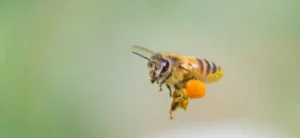
We all know honeybees are important pollinators for our flower, fruits and vegetables. They are also nature’s perfect delivery vehicles for applying chemicals to plants via the flower. Bees have delicate dexterity, wonderfully small, fuzzy bodies, and an unsurpassed aptitude for flying from flower to flower. But pollen is not the only beneficial cargo that bees could spread among flowers. Beneficial mocrobes can now be deliverd directly to plants by the industrious honeybee
This is a new use for our old friend the honeybee. Bees are being bred and delivered to farms armed with an arsenal of good, useful benefits. This new technology using bees has been called Bee Vectoring Technology. That’s a big name for a small but important new work assignment for the bee. In addition to pollinating plants, bees can now be used to combat disease and the devastation of crop loss. Share your thoughts on this exciting new innovation in the comment section below.
For this new technology, commercially reared bees deliver targeted crop controls through pollination, replacing chemical pesticides with an environmentally safe crop protection system. Instead, the scientifically designed bumblebee hive allows bees to pick up a trace amount of pest control powders on their legs to spread as they travel within the field. It’s a very targeted and limited use of pest and disease control.
This innovation in agriculture technology supports improved sustainable farming, crop yield, and soil quality. The system doesn’t require spraying water or the use of tractors. The idea is that, since many plant pathogens spread by inoculating flowers, farmers could prevent disease outbreaks by getting bees to deliver beneficial microbes to the flowers first. Those beneficial microbes either outcompete or outright kill the would-be infectious agent.

That’s right, we can now use honeybees, bumble bees, and orchard bees to deliver biological control agents to crops. Apple and pear trees, for example, suffer from fire blight, from a bacterial infection that first colonizes the stamen of the blossoms. However, some types of non-harmful bacteria introduced by bees will prevent fire blight by colonizing the flower stamen first – before the blight infection – outcompeting for resources and effectively “starving out” the blight before it can establish itself.

How does it work? Farmers hire commercial beehive operatiors to pollinate crops. The hive operator also adds a dispenser in the hives that holds the powdered chemical. As the bees exit the hive, they walk through the powder and carry it to the crops. When the bees land and shake to release pollen from the plant, the chemical agent is dropped into the flower where it acts a preventative measure against certain pests.
Pesticides and anti-fungal agents delivered by bees isn’t a cure-all and won’t prevent every type of crop disease. It is a solution that is best suited for diseases that affect crops through the flower. While it doesn’t work for every application, it is an exciting new field. Plus it gives new meaning to the term “worker bee”.
We do know of one innovation that works in most every application. Of course, we’re talking about Drinking Post Frost Free Automatic Livestock Waterers as the best innovation to your watering needs. A Drinking Post provides an unlimited supply of fresh water for your animals year-round. Specially purposed bees don’t play into the mix. You only need a connection to a pressurized water source to turn the Drinking Post into your own “worker bee”.
A Drinking Post is a frost-free automatic waterer that provides an unlimited supply of water for your animals year-round. A Drinking Post waterer works and installs like the more familiar frost-free yard hydrant. By keeping the operating valve 18 inches below the frost line, water comes up from below the frost line and drains down to below the frost line. Your animals simply push the paddle to fill the bowl with fresh water. When the animal finishes drinking, they release the paddle allowing all remaining water to drain below the frost line. Best of all, you can connect your Drinking Post to any pressurized water line.
Since all the water drains away after each use, there is never any standing water in the unit – and since there’s no standing water, there’s nothing in there to freeze! That’s how we’re able to keep it frost-free year round without using any electricity. Also, since the Drinking Post fills with new, fresh water with every single use, it stays incredibly clean! The animals love the fresh, clean water and you won’t have to spend your time cleaning it to keep it that way. No standing water means no freezing, but it also means no algae growth! There is never any algae growth in the Drinking Post.
Find answers to all your Drinking Post questions today at: https://dpwaterer.com/faq . Be sure to comment below and share this article using the social media links.